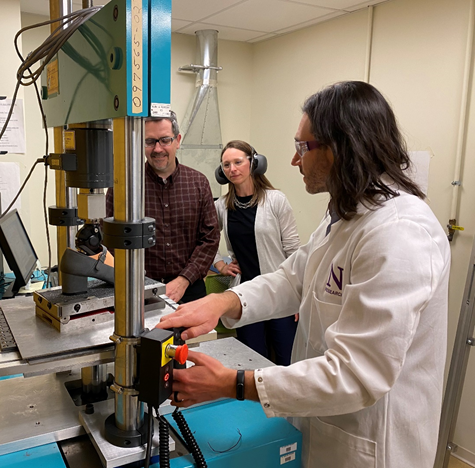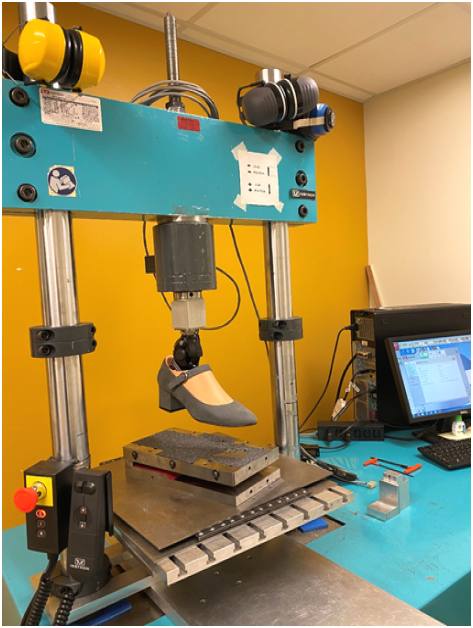


Posted June 2, 2020
Elizabeth Russell Esposito, Ph.D., DoD-VA Extremity Trauma and Amputation Center of Excellence (EACE), VA Puget Sound

Elizabeth Russell Esposito, Ph.D, EACE, VA Puget Sound

Matthew Major, Ph.D., Northwestern University

Andrew Hansen, Ph.D., Minneapolis VA

Christopher Erbes, Ph.D., Minneapolis VA

Billie Savvas Slater, M.A, Minneapolis VA

Andrea Ikeda, M.S., CP, Shirley Ryan Ability Lab
Having the choice to wear desired footwear or footwear deemed appropriate for a given occasion is an important part of community reintegration following lower limb amputation. Women typically own more pairs of shoes than men and have a greater variety of styles. A return to pre-amputation activities can include a return to using desired shoes. As the recipient of a Fiscal Year 2016 Prosthetics Outcomes Research – Funding Level 1 award, Dr. Elizabeth Russell Esposito and the research team from the Minneapolis VA, Northwestern University, and Shirley Ryan Ability Lab are characterizing perceived limitations in footwear among women prosthesis users using a survey distributed to a nationwide sample of women Veteran and Service member prosthesis users. They are also comparing how different styles of women’s footwear may change the mechanical properties of various adjustable heel height prosthetic feet.
In a March 2020 presentation to the American Academy of Orthotists and Prosthetists in Chicago, the study team highlighted some of the research findings to date from the surveys. Respondents indicated how strongly they agreed or disagreed that the width, height, and shape of their prosthetic foot made it difficult to fit in shoes. They also responded to how frequently they wore a variety of different footwear options pre amputation and also post amputation, and how important it was for them to wear a certain style of footwear.
Athletic shoes were the most commonly worn shoe prior to amputation and remained so after amputation. 85% of individuals rated athletic shoes as “moderately”, “very”, and “extremely” important to wear. Sandals, flat shoes, heeled shoes and sandals, and boots were all worn with less frequency after amputation compared to prior amputation. Of note, over half of the survey respondents indicated wearing high heeled shoes at least monthly or more often prior to amputation but not one person indicated wearing them at all post-amputation. Despite these results, 23% of respondents reported high heels as “moderately”, “very”, and “extremely” important to wear. Respondents also rated their footwear avoidance out of concerns for safety during activity. Surprisingly, the overwhelming majority of participants did not avoid certain shoes out of concern for safety (86.8%) or fear of foot slipping out of the shoe (92.1%). Prosthetic foot dimensions were more prohibitive, however. Over 50% of respondents “agreed” or “strongly agreed” that the width, height, and shape of their prosthetic foot made it difficult to fit in shoes. The data confirm previously anecdotal reports of challenges and limitations for women prosthesis users in terms of footwear able to be worn and desired to be worn. Women want to be able to wear a greater variety of footwear than they currently do, which may contribute to the greater dissatisfaction previously reported in women prosthesis users compared to their male counterparts.
The survey that was distributed to women prosthesis users covers much more than footwear and also examines mobility, body image, balance confidence, community participation, and quality of life. This project was recently awarded additional funding from Joint Program Committee 8 / Clinical and Rehabilitative Medicine Research Program to compare responses from women to an existing data set on over 200 men with lower limb amputations that study team member Dr. Christopher Erbes from the Minneapolis VA previously collected. Support of this analysis will provide a broad-ranging analysis and characterization of factors that affect quality of life that women experience relative to men after a lower limb amputation.
 Dr. Matthew Major demonstrates to Drs. Hansen and Russell Esposito the mechanical testing setup that evaluates how shoes affect the stiffness properties of adjustable heel-height prosthetic feet.
Dr. Matthew Major demonstrates to Drs. Hansen and Russell Esposito the mechanical testing setup that evaluates how shoes affect the stiffness properties of adjustable heel-height prosthetic feet.
 The mechanical testing setup to evaluate the stiffness properties of different prosthetic foot and footwear combinations.
The mechanical testing setup to evaluate the stiffness properties of different prosthetic foot and footwear combinations.
Link:
Women-Specific Footwear With Prosthetic Feet
Last updated Friday, December 13, 2024














